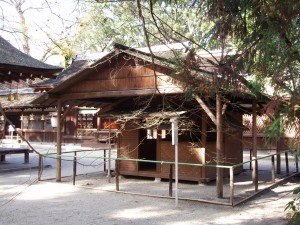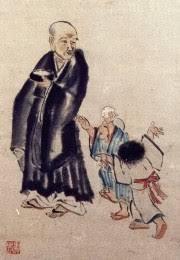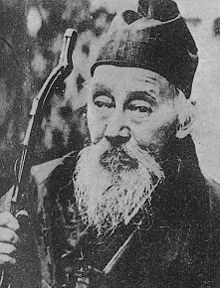
Model of Kamo no Chomei’s hut beneath the large protective roof.
Kamo no Chomei (1153-1216) was the son of a Shimogamo priest in Kyoto, and he was brought up in the large imperial shrine. Still today the shrine honours his memory by hosting a model of the famous hut in which he lived in later life. At some point in his youth, Chomei became disillusioned with his Shinto career, and it’s thought he might have been piqued by being passed over for promotion. He dropped out and took orders as a Buddhist monk, going to live in a hut in the mountains to the south-east of Kyoto. Here he wrote his famous book, Hojoki (The Ten-foot Square Hut), a wonderful account of a life close to nature.
 Ryokan Taigu (1758-1831) was the son of a town elder in Niigata who looked after the local shrine and performed its rites. Ryokan didn’t want to take over the position and instead joined the Zen sect, studying at a temple in Okayama and later becoming a wandering monk. He returned in middle age to his hometown, where he lived in a hut on a hill just outside the village. Here he wrote much of the poetry for which he is famous. He also wrote calligraphy but his chief joy was in playing games with the village children. When he became too old to maintain his solitary lifestyle, he moved down to live in residence at a shrine at the base of the mountain. ‘I feel like a ritualist,’ he said. The daily offerings and obeisance he made to the kami went along with his Zen practice and meditation.
Ryokan Taigu (1758-1831) was the son of a town elder in Niigata who looked after the local shrine and performed its rites. Ryokan didn’t want to take over the position and instead joined the Zen sect, studying at a temple in Okayama and later becoming a wandering monk. He returned in middle age to his hometown, where he lived in a hut on a hill just outside the village. Here he wrote much of the poetry for which he is famous. He also wrote calligraphy but his chief joy was in playing games with the village children. When he became too old to maintain his solitary lifestyle, he moved down to live in residence at a shrine at the base of the mountain. ‘I feel like a ritualist,’ he said. The daily offerings and obeisance he made to the kami went along with his Zen practice and meditation.

Tomioka Tessai, (1837-1924)
Tessai Tomioka (1837-1924) was born in Kyoto, as the second son of a man who sold sacerdotal robes. His father died in 1843 and the family fortunes declined, as a result of which young Tessai became a trainee at a Shinto shrine. Twelve years later, he lodged with a Buddhist poet and nun, Ōtagaki Rengetsu, who would become his mentor. He studied under a number of painters and worked as a Shinto priest at a number of shrines, but resigned when his brother died so that he could look after his mother. Tessai used rich colors to portray scenes of people in landscapes, often illustrating a historical or literary episode. He also made use of religious imagery, combining Buddhist deities with Daoist or Confucian figures to symbolize the unity of the Asian religious tradition. He was an early teacher of art at Ritsumeikan University, and it has been estimated that he painted some 20,000 paintings in all. His best works were created late in life, after age 80.
Shigemori Mirei
Ryokan

Interesting that you should post this article. I was recently hiking in a area known as Hino-no Satoyama, in the southern area of Fushimi-ku, where Kamo-no Chomei lived. There is a plaque there.
Thank you for mentioning that. I’ve never seen the site of Chomei’s famous hut, but there’s a website of someone who did, with the following instructions: take the Tōzai Line of the Kyoto City subway to Ishida (石田駅) and head southeast from the exit, passing a Seven-Eleven and following the turns indicated on the signs along the way. The website has a photo of the nondescript sign marking the alleged spot: https://nomad.cm/2013/11/07/chasing-a-recluse-kamo-no-chomei/